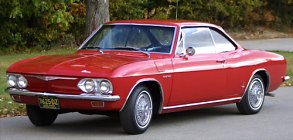 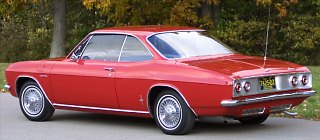 The 1965 Chevrolet Corvair Corsa was a very unusual car by American standard. It was powered by an air-cooled flat-6 engine mounted at the tail, very much like a Porsche 911. Its engine had aluminum heads and block. It was the first American production car using monocoque chassis instead of body-on-frame construction. It had all independent suspensions by double wishbone up front and a 3-link setup at the rear. Everything sounds like a European car, isn't it ? It even looked like an European car, with the subtle and elegant design so lacking in contemporary American cars. The history of Corvair began in 1960. GM originally wanted to build a compact car as an answer to Volkswagen Beetle. It copied the Volkswagen's formula by using rear-engined layout and an air-cooled horizontally opposed engine. However, instead of four cylinders and 1200 cc, it had 6 cylinders and 2300 cc to serve the American customers better. It was also much longer and wider than the Volkswagen to provide more interior space. Unfortunately, although the Corvair did outsold Beetle in the United States, it was never as popular as GM hoped for. The reason is obvious: its unconventional mechanical construction resulted in little component sharing with other GM cars, hence high cost compared with conventional rivals. In addition to an unattractive design, the bread-and-butter Corvair sedan would be forgotten by the world soon. 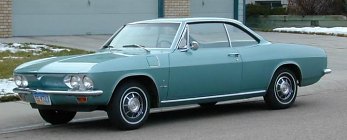 Not so the top-of-the-line coupe and spyder version called "Monza", or "Corsa" from 1965. They were loved by keen drivers for agile handling. The 60 percent rear-biased weight distribution contributed to a light steering and neutral feeling, a sharp contrast to its nose-heavy American rivals. The rearward weight bias also means it didn't need any disc brakes to achieve superior braking performance. However, the early Corvair Monza had some weaknesses to prevent it from being considered as a classic car. Firstly, it didn't look beautiful enough. Secondly, its engine lacked punch. Although displacement grew to 2.4 liters and eventually 2.7 liters in the following years, it produced no more than 110 gross horsepower. Thirdly, its combination of swing axle rear suspension and rearward weight bias could result in severe oversteer under body roll and limited its driver appeal. Chevrolet sorted out these problems in 1965 by introducing a completely revamped body (as pictured), a new 3-link rear suspension adapted from Corvette Sting Ray and a 140 hp version engine in the new flagship model Corsa. The new Corvair Corsa finally got the looks and handling it deserved, although performance could be described as decent rather than remarkable – 0-60 mph took around 10 seconds. You can see it as a poor man's 911. 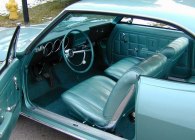 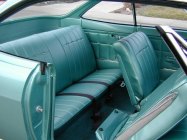 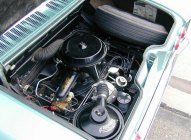 The Corvair is also remembered for being the world's first production car (together with Oldsmobile F-85 Jetfire) to feature turbocharging. As early as 1962, Chevrolet fitted a turbocharger to the 2.4-liter flat-six and produced 150 horsepower. By 1965, the 2.7-liter turbocharged Corsa added another 30 horsepower. Nevertheless, GM's turbocharging technology was prematured. At a time without any wastegates, boost control, recirculating valves or low inertia turbines, the engine had severe turbo lag and displayed stronger output only at high speed. This mean 0-60 mph was actually no quicker than the normally aspirated Corsa. For this reason, the turbocharged Corvair was considered to be a failed experiment. Overall, GM produced 1.8 million units of Corvair in various body style, including 235,000 units of 2-door Monza and Corsa from 1965. Sales dropped significantly since 1966 because of the book "Unsafe at Any Speed" written by a young lawyer called Ralph Nader. In that book, Nader attacked the Big 3 for producing unsafe cars. It took the early Chevrolet Corvair as an example, describing how its rear-engined layout and swing axle suspension led to unpredictable oversteer hence accidents. Although Corvair had already switched to new suspension by the time the book published, the negative publicity damaged its reputation. However, what killed the Corvair was not Ralph Nader but pony cars. The huge success of Ford Mustang forced GM to develop its own pony car, Chevrolet Camaro. It overlapped with Corvair but provided more performance and features. GM stopped promoting Corvair in the last years and let it died quietly in 1969. A sad end to probably the most unusual American production car in history. |